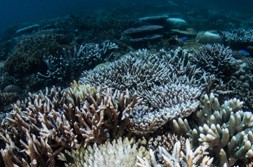Warming Oceans Bleach Coral Reefs

By Rita Waimer
Coral reefs color seabeds in shallow, warm seas all over the world, but what many people may forget is that they are actually living organisms. Beyond that, they are diverse habitats that are home to all types of marine life. And just like all of the fish that call them home, coral reefs can die.
A piece of coral is mostly made up of tiny animals called polyps that survive by feeding on small creatures that pass close by. Their color, however, comes from single-celled algae called Zooxanthellae that photosynthesize food, some of which is passed to the host coral.
The Effects of Climate Change on Coral
Together, the polyps and algae co-exist in a delicate balance that can be affected by a number of things, one of which is fluctuations in water temperature. That’s exactly what has led to the bleaching of coral in the Maldives this year, as well as the bleaching of the Great Barrier Reef and reefs in Western Australia.
This year’s record high temperatures warmed waters in the Indian Ocean around the Maldives, and that increase in water temperature put stress on the coral. In turn, the coral expelled the colorful algae, leaving nothing but nearly transparent tissue over a stony skeleton.
A Global Event
The Maldives Marine Research Center and the Environmental Protection Agency studied the bleaching event in partnership with the International Union for Conservation of Nature (IUCN) and found that more than 60 percent of coral reefs in the island chain were affected, with up to 90 percent of reefs affected in some areas. This bleaching event started in 2014 with a strong El Niño in the Pacific Ocean and has since become the longest bleaching event in recorded history. In October of 2015 the U.S. National Oceanic and Atmospheric Association declared it a global bleaching event. And Coral Reef Watch coordinator Mark Eakin said that it could last well into 2016, which has proven to be true.
It is possible for corals to recover from bleaching, but severe and long-term bleaching like this can be lethal. If the corals do die, the structures they built will quickly erode, wiping out habitats for ecologically and economically important marine life, and leaving the coast of the Maldives more vulnerable to storms.
CLASSROOM DISCUSSION
- How widely could the bleaching phenomenon spread if the trend of rising temperatures continues?
- How could the loss of coral reefs affect the people who live in the Maldives?
VOCABULARY
- Coral
- Zooxanthellae
- Polyp
- Bleach